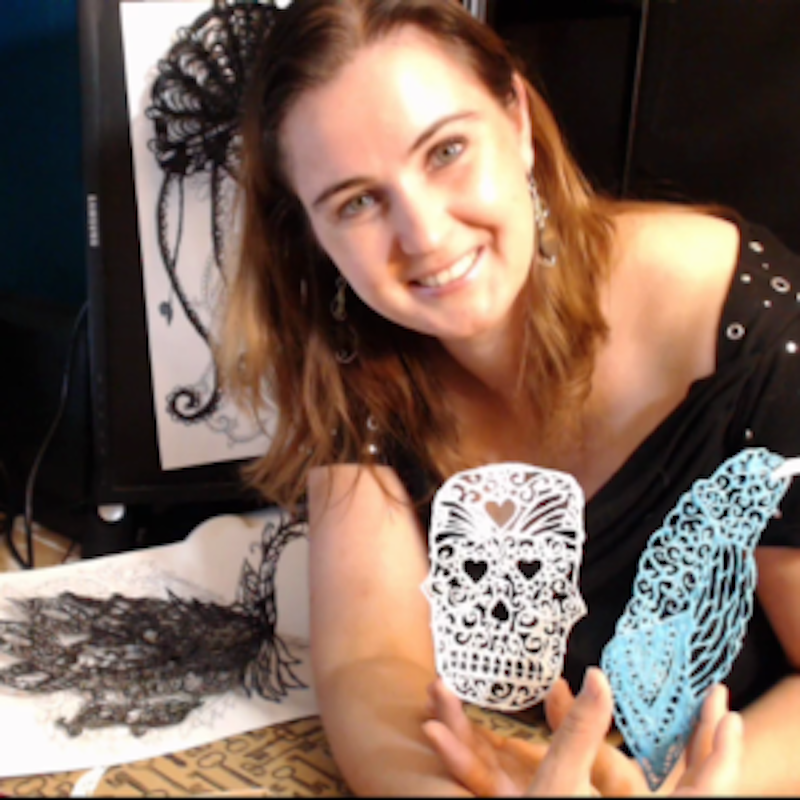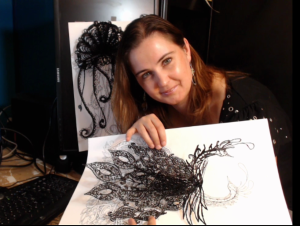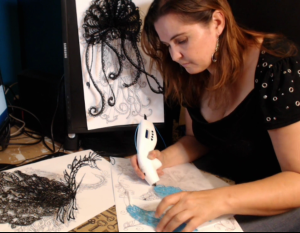
This article originates from Women In 3D Printing and is part of our effort to support the use of 3D printing technology by women. The article is re-published with permission.
Katherine is an innovator, a mother, a maker, an entrepreneur. She built a live-streaming 3D printing platform, MyMultiExtruder, on which she shares her 3D printing experiences. Just as we were all beginners at some time, Katherine experienced failed prints and frustration. This is what she is interested in documenting through her platform. This is the “wisdom of failure” in (3D) action.
Nora Toure: Katherine, could you let us know about your background and what brought you into 3D printing in the first place?
Katherine Bialek: I am a married mother of two, working as an electronics technician. I also run a couple of yearly craft show events in my city, and have recently become a landlady for a few suites. I have always had many hobbies, and I am constantly coming up with inventive ideas. Like most, I was blown away when I learned about 3D printing. While it was only a few years ago, my ideas since then have felt more within reach. I wanted to design my own line of children’s toys, a life long dream, and now being a new landlady with many repairs and renovations to consider, it was enough to get me to jump in and get my 3D printer. I guess you could say when my artistic hobby also met my business needs, I gave myself the green light.
Nora Toure: Do you remember your first 3D printed design?
Katherine Bialek: My first design was a set of bowling pins small enough for my shuffleboard table. I knew my kids (and myself!) would absolutely love to have that added spin on the game. I have since made several sets, and they seem to get a lot of curious attention in my Etsy store. If people can get a kick out of them, then I’m very happy!
Nora Toure: You built a live-streaming 3D printing platform, MyMultiExtruder. What should we know about this platform?
Katherine Bialek: I built this platform specifically to show the entire process. More specifically, to show the setbacks, failures, frustrations and learning curves. When I decided to buy my RoVa3D 5 nozzle 3D printer, I threw myself into weeks of research. I found a lot of information from people who knew so much more than I did. I found very little information about the mistakes and setbacks. I would have loved to see the process of a normal everyday beginner like I was going to be. That is why I decided I would make this platform.
It was difficult to find videos of real-time prints. Everything was edited or time-lapsed. I couldn’t find print fails, or any way to actually see what really happens in real life when watching edited recorded videos. I saw that Youtube would be offering streaming, so I started looking into possible ways to eventually stream my hobby. My best friend is a wood carver who streams on http://www.twitch.tv under the name guillotinepress, and he not only showed me what a great platform Twitch was, but he spent many hours helping me to get set up and he has been a great support to me since. Had he not been so supportive, it may have been a much later and smaller part of my platform. Instead, it has become my main platform, complete with collaborations with other streamers and artists!
Nora Toure: Who are your followers?
Katherine Bialek: My followers really vary anywhere from other 3D printer owners, to those who are interested and want to get into it, to other streamers and other artists, to those who just really enjoy watching art.

Nora Toure: What is the most popular topic on the platform?
Katherine Bialek: So far, the most popular topic has been when I am turning 2D art into 3D art with my 3dSimo pen. I have partnered up with a Seattle artist by the name of Jennifer Lankenau who illustrates adult coloring books. She has been sending me her work before they come out in her soon to be released books, and I have been making 3D creations from them. They have been amazing fun, and people get really into it! There has also been a lot of curiosity towards my plans of attempting to build my own pinball machine out of mostly 3D printed parts. It may seem impossible, but it will be fun to be a part of!
Nora Toure: What process do you use to turn 2D into 3D?
Katherine Bialek: I take the 2D art and cover it with a clear paper. I am then able to trace the parts of the work that I find crucial to the shape, frame, and structure. I peel the pieces off the page and set them aside until I have enough to build part of the structure. I use the 3dSimo pen to basically weld the plastic of the pieces together. I don’t use all pieces of the 2d art, I just pick out the best shapes, and most structurally useful. I add some of my own art detail in between lines to give strength where it is needed, and I remove extra detail where it would be too complicated to reproduce. The trickiest part, has been creating extra pieces needed for structure, or for sides of the piece not seen in the art. For that part of the process, I have learned to take design elements from existing pieces, and fit them into other shapes in order to keep the art consistent through the entire build and design.

Nora Toure: Anything exciting coming up you’d like us to know about?
Katherine Bialek: I am so happy with the direction my art has been going with my 3dSimo pens that I have decided to expand into multicolored 2D to 3D art next. I will start with two colors in a hummingbird, and two or maybe three for a Phoenix. Jennifer Lankenau has already sent me her 2D versions, so I am only waiting on the new pens to arrive. One of my never seen before projects will be the build of my Filastruder, and experimenting with making my own filaments. I have been generously given potato starch pellets by a local farm. They are biodegradable with properties of plastic when mixed with PLA. I hope to make some sort of stable filament!
Nora Toure: Do you have any (fun or not) story about MyMultiExtruder to share with us?
Katherine Bialek: MyMultiExtruder is not a very easy name to pronounce. I get a lot of very funny variations when people try to speak with me live, and those become funny nicknames. I often mistakenly get called “excruder”, but I think the funniest is the streamer who calls me “My Ex”. He will say things like, “My Ex is here”, or “My Ex had a great idea”.
Nora Toure: As a woman entrepreneur, what was/is your biggest challenge? Any challenge specific to the 3d printing industry?
Katherine Bialek: My biggest challenge as a woman in this industry has been staying true to my platform. There is this invisible feeling, or maybe presence, that people who are into 3D printing know what they are doing. It makes you want to be embarrassed when things don’t go smoothly. It makes you want to prove you are just as good as anyone else doing this. My platform is about showing all the mistakes and frustrations, but it is not always easy to put yourself out there and to keep going when things go wrong or when a print fails. You are live in front of people, so in the middle of your frustration and confusion it is difficult to step back and explain what went wrong, and then try to figure out why, and learn it raw in front of people.
Nora Toure: What makes the 3D printing industry particularly interesting for you:
As a business person?
Katherine Bialek: Having the freedom to repair things when I don’t have parts for them is amazing. I enjoy inventing, finding solutions, and being able to carry out that process myself.
Nora Toure: As a woman?
Katherine Bialek: I love how people have been responding to my creativity and my art. How I now feel I can do something about the void in children’s toys. Not only can I dive deeper into my hobbies, (like the pinball machine I plan to make with mostly 3D printed parts) but my son and I are prototyping ideas together, too!
Nora Toure: What do you think of the 3D printing industry today? And how would you like to see it evolve?
Katherine Bialek: My first impression of the 3D printing industry was that it was too full of “things”. That everyone with a 3D printer was printing figurines, statues, pencil holders, vases, and as many “things” as they could. I then found something that I can’t get enough of. Customization. Now you can make your own chess set with any characters you like. You can make any piece connect to a set of toys. You can add pieces to sets you already own. You can turn a normal case into a piece of art. The usefulness in customization is already there, and I would love to see that continue to evolve.
Nora Toure: In your opinion, how could we encourage more women to become involved with 3D Printing?
Katherine Bialek: By showing how 3D printing applies to our artistic sides. Tap into the crafting community and fill that void. So many women are so involved in their art, whether it be soap making, baking, sewing, knitting, painting, carving, candle making or any number of amazing creative talents they put their hearts and souls into. Show soap and candle makers that they can make their own unique custom molds. Show fiber artists that they can make custom buttons and embellishments. Show how they can break free and let their imagination make their products unique.
If you are interested in learning more about Katherine and her work, I invite you to visit her platform, MyMultiExtruder, here.
And don’t forget to join the Women in 3D Printing group on LinkedIn and Facebook. You can also show your support by donating – Your support will help maintaining the activities of this blog and building more events for the community.
Thank you for reading and for sharing!

